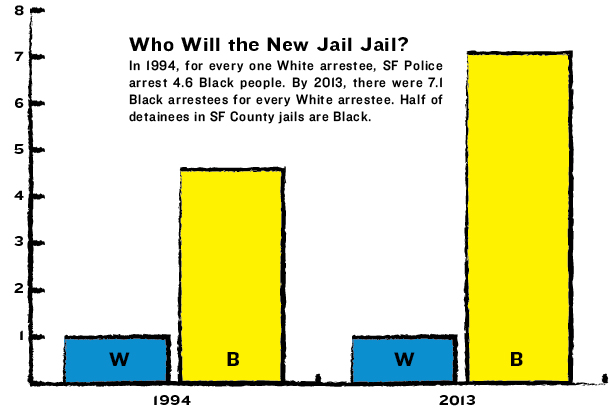
BY THE NUMBERS
- Number of county jails: 6 (four in San Francisco, two in San Bruno)
- Jail population, as of July 15: 1,260
- Capacity: 2,432 beds
- New beds under proposal: 384
By TJ Johnston
The San Francisco County Jail system is closer to expansion, despite objections that the expansion would be too costly, and opposition from advocates of currently and formerly incarcerated people, as well as homeless people.
On July 21, the Board of Supervisors approved both a measure to forgo further environmental review of the project and a resolution permitting the City’s application for state funding through 7-3 votes.
In adopting the resolution, the City could meet its August 28 deadline to ask the Board of State and Community Corrections for $80 million toward the overall $240 million cost, with the City paying the balance. A coalition led by the Oakland-based advocacy organization Critical Resistance said renovating the county jail would not benefit residents.
“Building a new jail is a negative plan to keep people with minor situations behind the wall,” said Samantha Rogers, project coordinator of California Coalition on Women Prisoners, one of Critical Resistance’s allied organizations.
In a report issued before the vote, Critical Resistance said paying more than $700 million in General Fund money for the jail, as well as hiring 500 police officers, would come at the expense of housing, public health, and other social service programs.
Despite reaching a 33-year low in the jail system’s average daily population, the Sheriff’s Department is asking to add 384 beds, scaled down from last year’s request for a 640-bed increase. City officials attribute the jail population’s drop to two main factors: the realignment of the state penal system, where low-level inmates are remanded to the counties, and the reclassification of “third-strike” felonies to misdemeanors under Proposition 47.
The Sheriff’s Department’s latest figures also show that 85% of the jail population are held on a pre-trial basis and half of detainees are African American. Though African Americans comprise just 6% of the city’s population, the W. Haywood Burns Institute noted that their arrest rate—and the disparity in arrests between whites and Blacks—increased in the last two decades. That ratio jumped from 1 white to 4.6 African Americans in 1994 to 1 to 7.1 in 2013.
According to San Francisco Department of Public Health’s 2011 numbers, up to 80% of inmates have substance abuse issues and 14% have severe mental illnesses.
Data compiled by the Burns Institute found that 21% of those who are charged provided no ZIP code, suggesting they were homeless at booking time.
Before voting against the jail expansion, Supervisor Jane Kim said that incarceration has become a systemic default response to poverty and health crises.
“Jails are the easy answer,” she said. “Our jails are increasingly being used as a convenient and easy answer to homelessness, to poverty, to severe mental health issues, and to drug rehab. This is a failure of society.”
Board President London Breed said that she always had reservations about the project. Even as she invoked her brother’s incarceration as the reason behind her initial doubts and admitted the dearth of available services, Breed ultimately voted for it.
“There are not enough mental health resources,” she said. “I feel like this process is death by a thousand cuts.”
The Sheriff’s Department touts rehab, medical, and educational programs in County jail facilities. However, Samantha Rogers said they are inadequate substitutes for community-based programs.
From 1993 to 2011, Rogers spent time in jail, prison, and parole, and she said that the lock-up environments are not conducive to recovering from traumatic experiences suffered in their lives before detention.
“You do have programs,” she said. “But how can you make this program work while you’re in a hostile environment?”
Five days before the final board vote, Jane Kim convened a hearing at the board’s Government Audit and Oversight Committee where alternatives to locking people up were discussed. Cristine DeBerry, Chief of Staff for the District Attorney’s Office, cited the Drake Hotel as an example. She told the panel that the hotel can house 42 people in the adult probation program and that detainees can have their specific needs assessed without whiling their pre-trial time in jail.
Matt Gonzalez, chief attorney of the Public Defender’s office, said at the committee hearing that a reformed bail system is also a key: it could reduce incarceration costs, lower racial disparities among detainees, as well as guilty pleas motivated by an earlier release.
During public comment, community members suggested pretrial diversion programs that could reduce or eliminate criminal penalties.
Voting with Kim against the proposal were Supervisors Eric Mar and John Avalos.
The proposed jail would cover 200,000 square feet at 850 Bryant Street in the South of Market neighborhood. The projected completion date is 2021.

